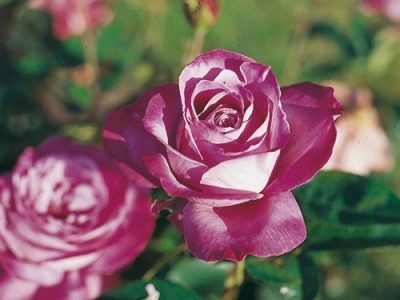
- Authors: Kordes
- Appeared when crossing: Blue Moon x Zorina
- Name synonyms: Blue River, KORsicht, Blue Lake, Blue Rive
- Breeding year: 1984
- Group: tea-hybrid
- The main color of the flower: lilac, purple
- Flower shape: cupped, high center
- Flower size: large
- Diameter, cm: 10-11
- Flower type by number of petals: thick double
The name of the Blue River variety is translated as "Blue River". This species has become in demand due to the bright color of the flowers, picturesque appearance and attractive aroma. Many flower growers consider the shape of the opened buds to be ideal, therefore this variety is actively used in landscape design. Only those who create suitable growing conditions for it will be able to enjoy the maximum beauty of the rose.
Description of the variety
Blue River belongs to the hybrid tea group. The variety is often not grown as a cut. The color of the buds is red, with a lilac tint. A distinctive feature of the variety is a dark purple edge, and in the process of blooming, the color of the bud gradually brightens. The petals on the outside acquire a rich purple color. The main color is purple or lilac. If the bush grows in a comfortable environment, the buds will be colorful.
Color type - two-tone. The shape of the closed buds is goblet, and the flowers are cupped, the center is high. The sizes are large, the diameter varies from 10 to 11 centimeters. Due to the large number of petals, the type of flowers is densely double (from 35 to 55 pieces). Flowers grow both in inflorescences and singly. On one stem, from 1 to 5 pieces are formed. Inflorescences are few-flowered. The intense fruity aroma is noted separately.
The bushes reach a height of 80 to 100 centimeters. Width - about 75 centimeters. It is a medium-sized and branched plant. The foliage is dark green. Sizes are medium. The stems are covered with thorns.
Advantages and disadvantages
Blue River Pros:
- resistance to diseases and infections;
- refined and bright aroma;
- saturated color of the petals;
- voluminous flowers.
As disadvantages, only weak foliage in the lower part of the plant is noted. To hide this, undersized varieties are planted in front of the bushes.
Flowering features
This variety blooms profusely and throughout the summer. This is a continuous process, therefore, during this period, the bush is covered with a large number of bright flowers. The buds open slowly.
Use in landscape design
The Blue River is often planted along terraces and benches. This fit looks as impressive and advantageous as possible. The rose is remarkably adjacent to perennial plants in the same flower bed. To maximize the beauty of this culture, it is used as an element for non-standard floral arrangements.
To highlight the vibrant color of the Blue River variety, roses or other rich red or burgundy flowers are planted next to it. The rose perfectly coexists with carnations or monarda. For self-planting, this variety is also suitable.
Landing
Choose a planting site in spring or autumn. When buying seedlings, you need to pay attention to the condition of the root system, and the shoots should be well branched. Blue River prefers open and sunny areas. Getting enough sunlight, the rose will delight with lush flowering before the cold weather arrives.
Before planting, it is advisable to leave a young bush in a container with a small amount of water overnight. The next day, the seedling is examined again, cutting off too long roots.
Suitable pit sizes for planting are 50x50x50 centimeters. A portion of fertile soil is poured into the bottom of the hole, and soil mixed with compost is laid on top. Irrigation depressions are dug nearby.
Growing and care
Rose prefers regular watering.It is resistant to both heat and cold, withstanding frosts down to -20 degrees Celsius. In areas with little snow and severe winters, plantings should be covered. Sawdust, fallen oak leaves and coniferous spruce branches are used as shelter. Before covering the bushes for the winter, they are cut off, and the top layer of soil is dug up.
Resistance to atmospheric precipitation is poor. Despite the fact that the variety prefers illuminated areas, it also develops well in partial shade. A slight lack of sunlight will not affect flowering, but will reduce disease resistance.
The plant must be protected from cold winds, while for a comfortable development, seedlings should be planted in ventilated areas. Air circulation is considered one of the mandatory rules of agricultural technology. The foliage should be thoroughly ventilated, especially during periods of intense rainfall.
Soil composition also plays an important role. Land that is rich in nutrients is great. Depleted soil is fed with organic matter or any other nutrient composition. The soil texture should be loose to avoid stagnant water.
Watering and feeding
The decorative qualities of the plant directly depend on the care. The Blue River variety needs moderate and regular watering, especially during dry periods. It is important to maintain a moderate level of soil moisture at all times. In summer, the bushes are irrigated up to twice a week.
Fertilizers are applied 2-3 times throughout the season. The first portion is applied in early spring, even before the start of the growing season. The second time the roses are fed during budding. The last time fertilizers are used is a month and a half after flowering. Experienced gardeners recommend opting for special formulations designed for growing flowering plants, including roses.































































